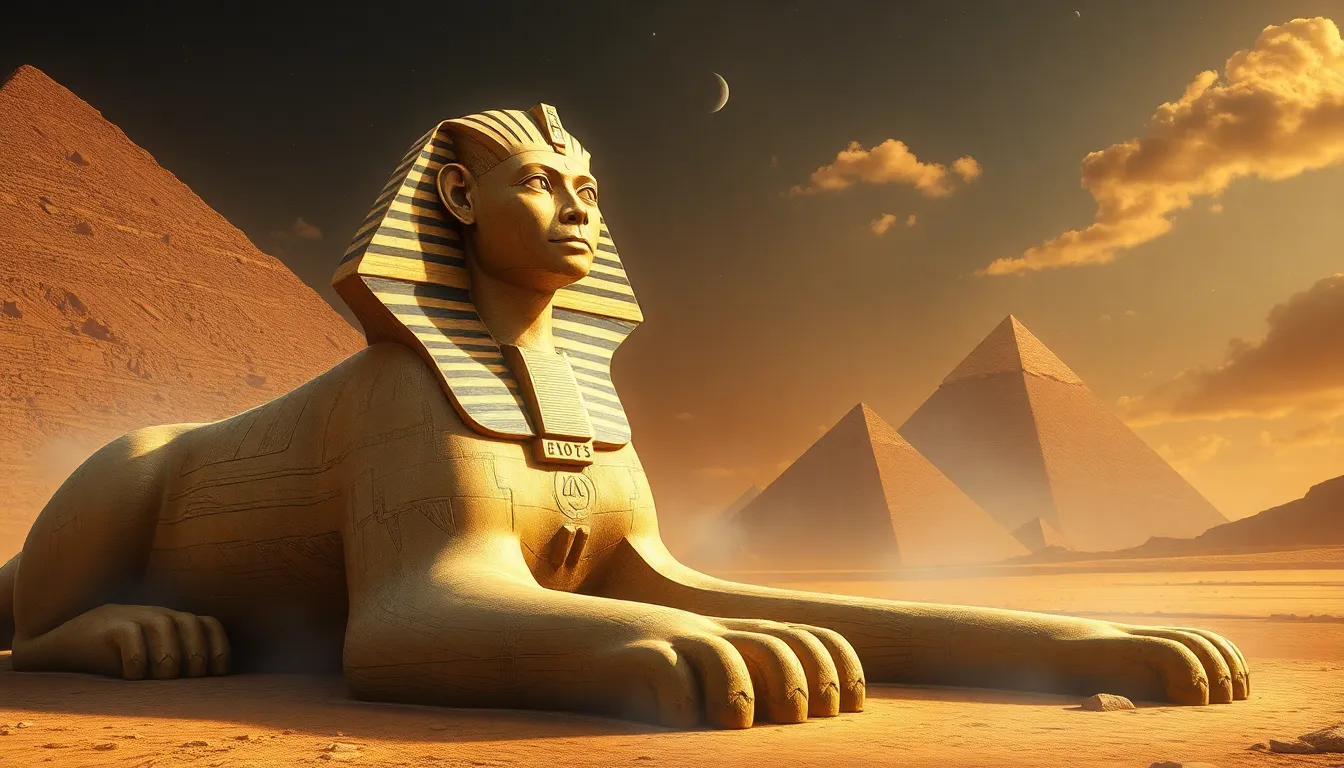The Role of the Sphinx in Egyptian Mythology
I. Introduction
Egyptian mythology is a rich tapestry of gods, goddesses, and mythical creatures that played a significant role in the lives of the ancient Egyptians. Among these figures, the Sphinx stands out as a symbol of strength, mystery, and protection. This mythical creature, with the body of a lion and the head of a human, has captured the imagination of people for centuries. In this article, we will explore the multifaceted role of the Sphinx in Egyptian mythology, examining its historical context, symbolism, narrative significance, and modern interpretations.
II. Historical Context of the Sphinx
The origins of the Sphinx can be traced back to ancient Egypt, where it emerged as a prominent symbol during the Old Kingdom period. The most famous example, the Great Sphinx of Giza, was built during the reign of Pharaoh Khafre around 2500 BCE. This colossal statue, measuring 73 meters long and 20 meters high, is believed to represent the pharaoh himself, serving both as a guardian of the Giza Plateau and a symbol of royal power.
Throughout history, the perception of the Sphinx has evolved. Initially revered as a protector and a divine entity, it later became associated with mystery and enigma, partly due to its weathered appearance and the loss of its original nose. The Sphinx’s presence in various temples and monuments underscores its architectural significance and its importance in the cultural landscape of ancient Egypt.
III. Symbolism of the Sphinx
The Sphinx embodies a range of symbolic meanings. Primarily, it represents strength and protection. The lion’s body signifies power and courage, while the human head symbolizes intelligence and wisdom. This duality of form reflects the ancient Egyptians’ understanding of the balance between human intellect and animal instinct.
- Strength and Protection: The Sphinx was often seen as a guardian of sacred spaces, including tombs and temples.
- Connection to the Sun God Ra: The Sphinx is linked to the sun god Ra, embodying the concepts of rebirth and resurrection.
- Duality: The combination of human and animal features highlights the relationship between humanity and the divine.
IV. The Sphinx in Mythological Narratives
While the Sphinx is often associated with Egyptian mythology, its most famous narrative comes from Greek mythology, particularly in the story of Oedipus. In this tale, the Sphinx is depicted as a cunning creature that poses a riddle to travelers, devouring those who cannot answer correctly. Oedipus’s success in solving the riddle leads to the Sphinx’s demise, symbolizing the triumph of human intellect over brute force.
In Egyptian lore, the Sphinx shares characteristics with other mythological creatures, such as the griffin and the lamassu. These beings often served as guardians and were commonly depicted in ancient art. Myths surrounding the origins of the Sphinx suggest that it was created by the gods as a protector of sacred sites, reflecting its role in safeguarding the afterlife.
V. The Sphinx and the Afterlife
In Egyptian belief, the Sphinx was not merely a guardian of the living but also played a crucial role in the afterlife. It was often placed at the entrances of tombs, serving as a sentinel for the deceased. The Sphinx was believed to guide souls through the afterlife, ensuring safe passage and protection from malevolent forces.
- Guardian of Tombs: The Sphinx’s presence at tomb sites signified protection for the deceased on their journey to the afterlife.
- Guidance for Souls: The Sphinx was thought to provide guidance to the souls of the departed, leading them toward the realm of the dead.
- Funerary Texts: References to the Sphinx in funerary texts and rituals highlight its importance in the spiritual journey of the deceased.
VI. Interpretations and Representations in Art
The Sphinx has been a prominent subject in ancient Egyptian art, depicted in various forms and styles throughout different dynasties. Its representation often reflects the artistic conventions and religious beliefs of the time. From monumental sculptures to smaller amulets, the Sphinx served as a powerful symbol across a range of artistic media.
Over the centuries, the imagery of the Sphinx has evolved, with changes in artistic style reflecting broader cultural shifts. The influence of the Sphinx can also be seen in later art and literature, inspiring countless interpretations of mythological creatures in various cultures.
VII. Modern Perspectives on the Sphinx
In contemporary culture, the Sphinx remains a significant icon, attracting tourists from around the globe to sites like Giza. It has become a symbol of ancient Egyptian civilization, often featured in films, literature, and popular culture. Ongoing archaeological studies continue to uncover secrets surrounding the Sphinx, shedding light on its historical and cultural significance.
Moreover, modern interpretations of the Sphinx often explore its duality and the themes of knowledge versus ignorance, reflecting the complexity of its nature. As a subject of fascination, the Sphinx invites ongoing exploration and discussion among scholars and enthusiasts alike.
VIII. Conclusion
In summary, the Sphinx holds a vital place in Egyptian mythology, serving as a symbol of strength, protection, and intelligence. Its rich historical context, profound symbolism, and narrative significance highlight its enduring legacy in ancient Egyptian culture. As we continue to study and explore the myths and beliefs of ancient Egypt, the Sphinx remains a captivating figure that invites us to delve deeper into the mysteries of the past.
As we reflect on the Sphinx’s significance, we encourage further exploration and study of Egyptian mythology, a field that continues to unveil new insights into the beliefs and practices of one of the world’s most fascinating ancient civilizations.




